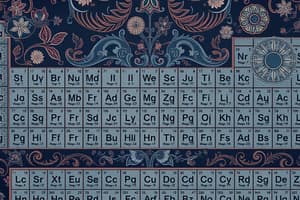Podcast
Questions and Answers
What term describes organic molecules that contain only carbon and hydrogen?
What term describes organic molecules that contain only carbon and hydrogen?
- Alkanes
- Polymers
- Carbons
- Hydrocarbons (correct)
Which functional group is primarily responsible for the chemical properties of organic molecules?
Which functional group is primarily responsible for the chemical properties of organic molecules?
- Functional groups (correct)
- Carbon skeletons
- Polymeric chains
- Hydroxyl group
What is the primary reason for the diversity of biological molecules?
What is the primary reason for the diversity of biological molecules?
- Presence of only carbon and hydrogen
- Complex structures made of identical subunits
- Variety of carbon chains
- Different functional groups (correct)
Which class of biological monomers includes sugars composed of carbon, hydrogen, and oxygen?
Which class of biological monomers includes sugars composed of carbon, hydrogen, and oxygen?
What type of reaction links monosaccharides to form more complex carbohydrates?
What type of reaction links monosaccharides to form more complex carbohydrates?
What percentage of total body mass do carbohydrates typically constitute?
What percentage of total body mass do carbohydrates typically constitute?
How are biological molecules primarily structured?
How are biological molecules primarily structured?
What type of biological molecules does cholesterol serve as a modified structure for?
What type of biological molecules does cholesterol serve as a modified structure for?
Which of the following is NOT a class of biological monomers?
Which of the following is NOT a class of biological monomers?
Which property changes due to the different chemical structures of organic molecules?
Which property changes due to the different chemical structures of organic molecules?
What property of water allows it to absorb a significant amount of energy without a large increase in temperature?
What property of water allows it to absorb a significant amount of energy without a large increase in temperature?
Why do freshwater organisms survive the winter in icy conditions?
Why do freshwater organisms survive the winter in icy conditions?
How does the polarity of water contribute to its role as a solvent?
How does the polarity of water contribute to its role as a solvent?
In what range must the pH of blood be maintained for optimal physiological function?
In what range must the pH of blood be maintained for optimal physiological function?
What characteristic of ice contributes to its ability to float on liquid water?
What characteristic of ice contributes to its ability to float on liquid water?
What is the role of buffers in biological systems?
What is the role of buffers in biological systems?
What is the result of water's cohesive property?
What is the result of water's cohesive property?
What is the primary reason water is considered a polar molecule?
What is the primary reason water is considered a polar molecule?
Which of the following correctly describes the primary structure of a protein?
Which of the following correctly describes the primary structure of a protein?
What structural feature stabilizes the secondary structure of proteins?
What structural feature stabilizes the secondary structure of proteins?
In which structural level of proteins do disulfide bridges play a critical role?
In which structural level of proteins do disulfide bridges play a critical role?
What distinguishes a peptide from a protein?
What distinguishes a peptide from a protein?
Which type of protein structure includes the arrangement of multiple polypeptide chains?
Which type of protein structure includes the arrangement of multiple polypeptide chains?
Fibrous proteins are characterized by which of the following properties?
Fibrous proteins are characterized by which of the following properties?
What happens to proteins when they are denatured?
What happens to proteins when they are denatured?
Which of the following is a common characteristic of globular proteins?
Which of the following is a common characteristic of globular proteins?
How do hydrophobic interactions influence protein structure?
How do hydrophobic interactions influence protein structure?
The repeated folds of proteins in their secondary structure can include which of the following?
The repeated folds of proteins in their secondary structure can include which of the following?
Which component is NOT part of a nucleotide?
Which component is NOT part of a nucleotide?
What is the primary structural difference between DNA and RNA?
What is the primary structural difference between DNA and RNA?
During which process is DNA transcribed into RNA?
During which process is DNA transcribed into RNA?
Which type of RNA is primarily responsible for carrying the encoded messages from genes to ribosomes for protein synthesis?
Which type of RNA is primarily responsible for carrying the encoded messages from genes to ribosomes for protein synthesis?
What is the function of ribosomal RNA (rRNA) in cells?
What is the function of ribosomal RNA (rRNA) in cells?
What role do cofactors play in enzyme function?
What role do cofactors play in enzyme function?
Which of the following describes the enzyme-substrate interaction?
Which of the following describes the enzyme-substrate interaction?
Why is activation energy important in biochemical reactions?
Why is activation energy important in biochemical reactions?
What is a characteristic of enzymes concerning their specificity?
What is a characteristic of enzymes concerning their specificity?
What is the primary role of proenzymes in metabolic processes?
What is the primary role of proenzymes in metabolic processes?
What is the main function of enzymes in biological systems?
What is the main function of enzymes in biological systems?
What defines the efficiency of an enzyme?
What defines the efficiency of an enzyme?
How do enzymes return to their original state after a reaction?
How do enzymes return to their original state after a reaction?
What effect do enzymes have on the activation energy of a reaction?
What effect do enzymes have on the activation energy of a reaction?
Which statement regarding enzymes is true?
Which statement regarding enzymes is true?
Flashcards are hidden until you start studying
Study Notes
Water Properties
- Water exhibits cohesion, allowing molecules to stick together.
- Water moderates temperature, absorbing significant energy before increasing in temperature.
- Water absorbs heat during the day and releases it at night, aiding in temperature control.
- Ice expands upon freezing, creating a lattice structure that makes it less dense than liquid water, enabling it to float.
- Water is a polar solvent, dissolving hydrophilic substances easily while repelling hydrophobic substances like oils.
- Buffers in the body maintain pH within the narrow range of 7.35-7.45, crucial for physiological functions.
Organic Molecules
- Organic molecules contain carbon and consist of carbon skeletons connected by covalent bonds.
- Molecules exclusively made of carbon and hydrogen are termed hydrocarbons.
- Functional groups attached to carbon skeletons determine the chemical properties and functions of organic molecules.
- Biological molecules often exist as polymers composed of repeating monomers, including carbohydrates, lipids, proteins, and nucleic acids.
Carbohydrates
- Composed of carbon, hydrogen, and oxygen, carbohydrates make up 2-3% of total body mass.
- Monosaccharides are the simplest form of carbohydrates, serving as their building blocks.
- Dehydration synthesis links monosaccharides to form complex carbohydrates like disaccharides.
Proteins
- Proteins are polymers formed from amino acid monomers, linked by peptide bonds via dehydration synthesis.
- Peptides consist of a few amino acids, while polypeptides can range from 10 to 2000 amino acids.
- The primary structure of proteins is defined by the amino acid sequence determined by genes.
- Secondary structures include repeated folds (α-helices or β-sheets), stabilized by hydrogen bonds.
- Tertiary structure refers to the three-dimensional conformation, influenced by various bonds and interactions.
- Quaternary structure describes the arrangement of multiple polypeptide chains in proteins that have this complexity.
- Proteins can be classified as fibrous (insoluble, e.g., keratin) or globular (soluble, e.g., enzymes, antibodies).
- Denaturation refers to loss of structure in proteins, rendering them biologically inactive.
Enzymes
- Enzymes act as biological catalysts, speeding up chemical reactions without being consumed.
- Cofactors and coenzymes assist enzyme activity, enhancing catalysis.
- Enzymes exhibit high specificity, interacting with substrates at active sites through a "lock and key" mechanism.
- They improve reaction rates by lowering activation energy, critical for metabolic processes.
- Regulation of enzyme synthesis and activity is vital for cellular function.
Nucleic Acids
- Nucleic acids consist of carbon, hydrogen, oxygen, nitrogen, and phosphorus, mainly forming DNA and RNA.
- Genes are segments of DNA encoding specific proteins, with DNA transcribed to RNA, which is then translated to proteins by ribosomes.
- Nucleotides, the monomers of nucleic acids, comprise nitrogenous bases, a pentose sugar, and a phosphate group.
- DNA consists of deoxyribose sugar and bases A, G, C, T; RNA contains ribose sugar and bases A, G, C, U.
- DNA forms a double helix structure, with base pairs consisting of one purine and one pyrimidine.
- Three major types of RNA: mRNA (messenger), rRNA (ribosomal), tRNA (transfer), each serving specific roles in protein synthesis.
- DNA replication creates a new copy of the double helix using one strand as a template; mutations occur through changes in nucleotide sequences.
Studying That Suits You
Use AI to generate personalized quizzes and flashcards to suit your learning preferences.




